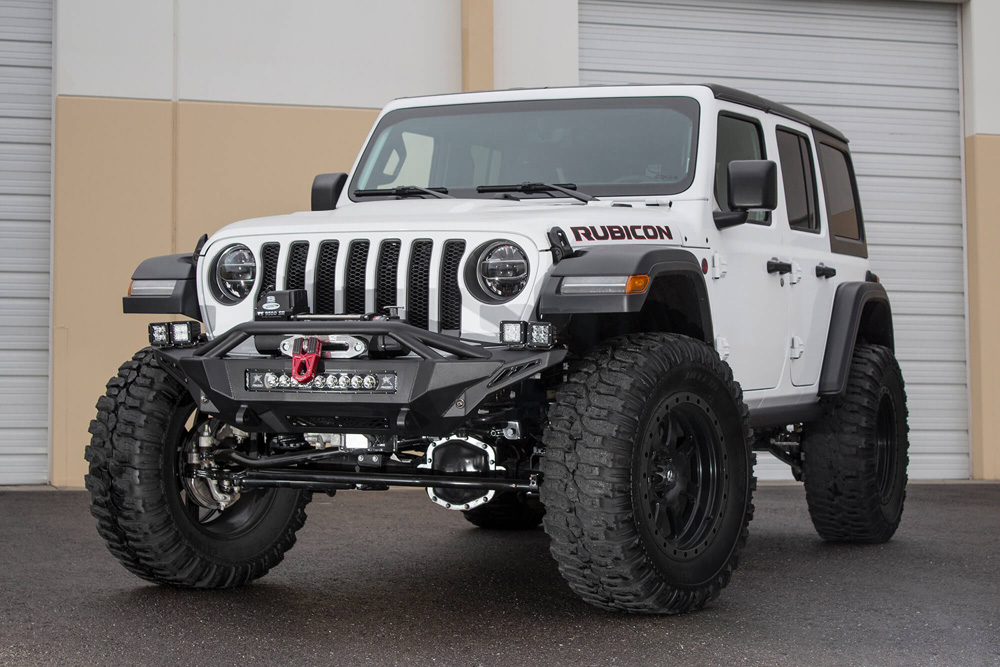Many people who own Jeeps love to lift them. It's not even rare to spot a lifted Jeep driving around – there's a good chance you see one every day. A lifted Jeep will perform better, turn heads, and give you much-needed space for larger wheels. While lift kits are awesome, it's important to understand both the advantages and disadvantages of installing one.
Luckily, Morris 4x4 has several different lift kits to choose from. You'll also have plenty of information to make an informed decision about Jeep lift kits.
Pros of Lifting Your Jeep

There's a reason that you see tons of Jeeps with a lift kit. A good lift kit will improve your off-road performance, give you more wheel options, and improve your Jeep's curb appeal.
Better Off-Road Performance
One of the biggest advantages of lifting a Jeep is the off-road performance. Off-road performance is increased with a lift kit for a few reasons. First and foremost, lift kits give the Jeep more clearance. Lifted Jeeps won't bottom out as often, so there's less to worry about when climbing hills or rocks.
Lift kits also improve off-road performance because they give you a foundation for more off-road modifications. Lifting your Jeep allows you to add sturdier suspension components, bigger wheels, thicker tires, and more. Some lift kits will even make it safer for you to drive through swamps and mud with a snorkel – another three to five inches of height makes all the difference sometimes.
The last thing to note about off-road performance is that you won't feel the ground as much. With the right lift kit, you'll have improved stability and feel fewer vibrations.
Room for Bigger Wheels and Tires
When it comes to upgrading your wheels and tires, your Jeep's stock suspension doesn't give you a lot of leeway. Unfortunately, you won't be able to install giant wheels or tires without rubbing and other issues. Fortunately, this changes when you install a lift kit. Installing a lift kit gives you more clearance to install larger wheels and tires.
Larger wheels and tires make it easier to climb over obstacles in your Jeep. Many larger tires also have superior durability. Plus, larger tires make your Jeep look more visually aesthetic. That said, make sure your Jeep has the necessary components to support larger wheels and tires.
Improved Appearance
Lifting a Jeep isn't just about performance, wheels, or even off-roading. Many people lift their Jeep because of their appearance. Lifted Jeeps look more aggressive and tower over smaller vehicles on the road. A lifted Jeep is also compatible with larger wheels and tires, which give a Jeep a more aggressive appearance.
Cons of Lifting Your Jeep

Lifted Jeeps are popular but they're not for everyone. Before lifting your Jeep it's important to understand the drawbacks. Some of the most notable drawbacks are a reduction in fuel efficiency, a reduction in braking, and an increased risk of tipping.
Reduction in Fuel-efficiency
The biggest disadvantage you'll notice is a reduction in fuel efficiency. Several factors contribute to fuel efficiency like the size of a vehicle's engine, its weight, and aerodynamics. Unfortunately, Jeeps are heavy vehicles and don't have much going for them in the aerodynamics department. When you add a lift kit all these problems worsen.
Lift kits will add weight to your Jeep, especially if you choose larger tires. The extra weight places more strain on your engine and reduces fuel efficiency. Lift kits also increase the height of your Jeep, which reduces aerodynamics and fuel efficiency.
Bigger tires that accompany lift kits also reduce fuel efficiency. The engine needs to work harder to turn bigger wheels and the wider contact area creates more resistance through friction. Bigger wheels and tires also add more weight, which also reduces fuel efficiency.
Less Stopping Power
Installing a lift kit will also change how the vehicle comes to a stop. When you install a lift kit along with bigger tires it takes longer for the vehicle to break. The larger diameter of the wheels and added weight are responsible for this issue. While the lift kit isn't necessarily the problem, most people don't get a lift kit to keep 17-inch wheels on their Jeep.
Increased Risk of Tipping
Lifting a Jeep will help it overcome obstacles when off-roading but you have to be careful. When you alter a vehicle's center of gravity by lifting it or lowering it, performance changes.
Vehicles that are low to the ground are bad for off-roading but excellent for turning corners. On the other hand, lifted Jeeps perform well off-road but have an increased risk of tipping. Furthermore, the risk of tipping increases based on how tall the Jeep is. This makes the risk of tipping greater in Jeeps that are lifted by three or four inches.
Accelerated Wear and Inaccuracies

Changing a Jeep's ride height will cause accelerated wear and inaccuracies if the job isn't done right. Angles of drive train components will no longer sync properly, which causes accelerated wear when parts rub and create friction.
You'll also have to overcome inaccuracies like changes with the speedometer. The speedometer is calibrated with the original wheels and ride height in mind. Changing the wheels and Jeep ride height leads to inaccuracies on the speedometer. For example, it might say you're going 30 but you're going 40.





